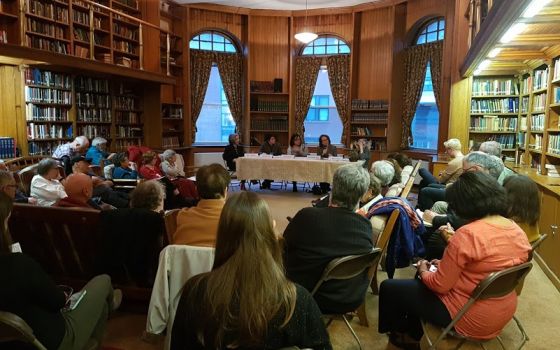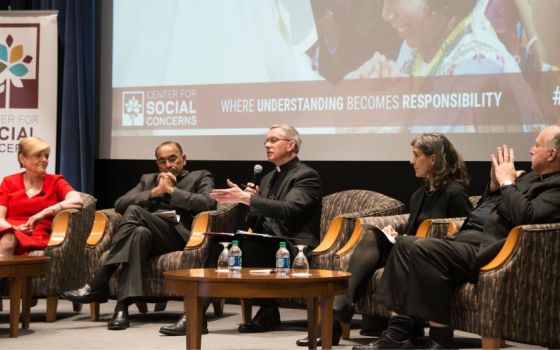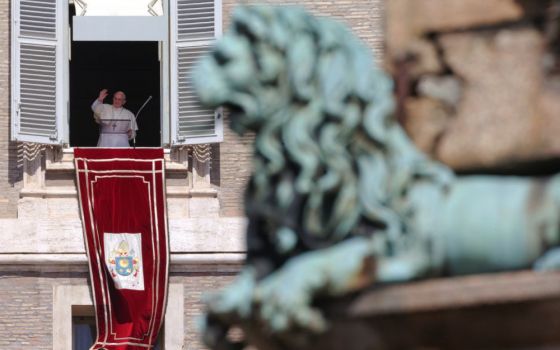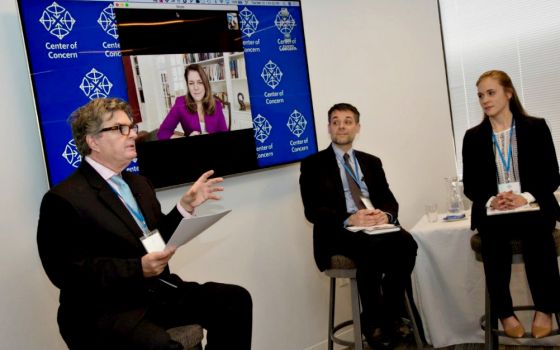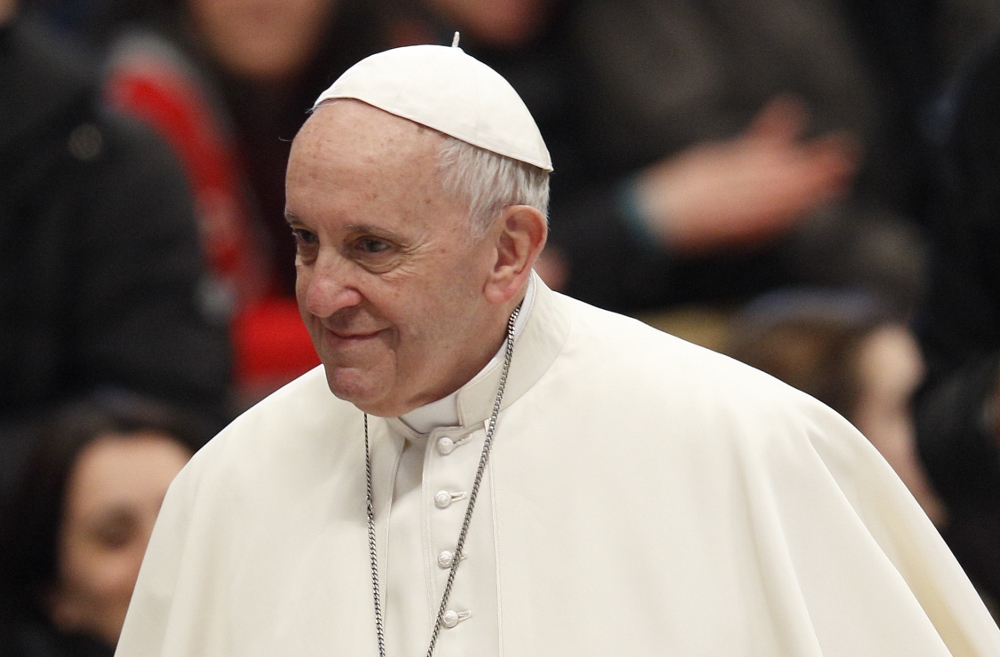
Pope Francis is pictured during his general audience in St. Peter's Basilica at the Vatican Feb. 28. (CNS/Paul Haring)
"Only if the reforms of the Second Vatican Council are continued can the church be saved," Fr. Hans Küng said in the fall of 2012 at a symposium marking the 50th anniversary of the opening of the Second Vatican Council. The Swiss theologian, who had been an adviser to the council (and will celebrate his 90th birthday March 19), had watched through the pontificates of John Paul II and Benedict XVI as the reforms of the council were implemented slowly, relativized by the magisterium, and, in many cases, massively obstructed and opposed.
Within a half of a year, Benedict would make history by being the first pope in nearly 600 years to resign. The resignation was necessary, not only because of his advanced age — he was 85 at the time — but above all because of a fundamental leadership crisis in the Vatican. Although for more than 30 years he held one of the highest positions in the Vatican, Cardinal Joseph Ratzinger had failed to really lead the Vatican and, once he became pope, failed to solve problems in the church, some of which he had inherited from John Paul II.
On March 13, 2013, Cardinal Jorge Mario Bergoglio, archbishop of Buenos Aries, Argentina, was elected pope. Although he had not himself witnessed the proceedings of the council in Rome, this cardinal came from a continent where the vision of this reform council has been consistently accepted and implemented.
From the first moment he was introduced to the world on the balcony overlooking St. Peter's Square, Pope Francis introduced a fundamentally new style in Rome, a pastoral style of leadership that the faithful had so long longed for.
He set the course of renewal for the church with stirring sermons and concrete signs, such as renouncing inherited symbols of power like titles and the papal apartments. He made his priorities plain when he made the destination of his first visit outside Rome the Mediterranean island of Lampedusa, a refuge for people fleeing war and economic deprivation.
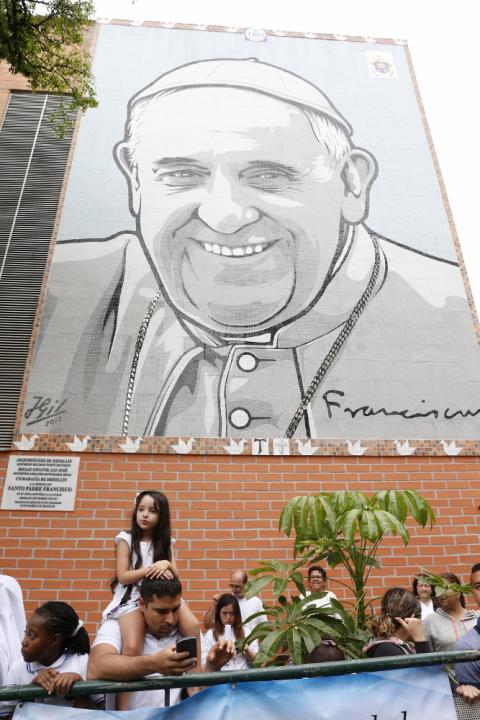
A mural of Pope Francis is seen in Medellín, Colombia, near Hogar San José children's home, which the pope visited Sept. 9, 2017. (CNS/Paul Haring)
The post-conciliar way of the Latin American church from which Francis comes is characterized by the clashes, above all, over liberation theology, which was strictly opposed for decades by Ratzinger when he was prefect of the Congregation for the Doctrine of the Faith. Bergoglio himself had repeated conflicts with the Vatican, and even experienced censorship himself. He is a representative of the "theology of the people," the Argentine version of liberation theology.
The theology of Vatican II, which was developed further in Latin America and matured in often-painful practice, is what Francis brought back to the Vatican. In many respects, Francis took up the interchurch reform projects and sociopolitical positions of Pope Paul VI. The claim that the church must be a church for the poor and the need for reform of the church structure go hand in hand with Francis. This was the core of the intervention he made before the papal election during the consistory of cardinals March 9, 2013. He said then that church reform and social reform, ecumenism ad intra and ecumenism ad extra belong together.
His writings set a course
On June 29, 2013, Francis issued his first encyclical, Lumen Fidei ("The Light of Faith"), but his predecessor had written much of it — "This is encyclical stands on two legs!" Vatican Radio reported — so it is a document of the difficult transition, a compromise between continuity and new beginnings that left the burning internal church issues still undecided. Much more attention was given three days later to Francis' symbolic first journey to the refugees on Lampedusa.
In November that year, Francis released his first apostolic exhortation, Evangelii Gaudium ("The Joy of the Gospel"), which was a much more programmatic doctrinal text and clearly showed the will to make concrete reforms, even in the church structure. On the basis of the Vatican II dogmatic constitution Lumen Gentium, Evangelii Gaudium contains a program of evangelization as well as demands and proposals for a thorough and lasting reform of church structures and their pastoral, diaconal and political functions. This begins with the Vatican and ends at parishes around the world. To see the world through the eyes of the poor, to read the Bible and to act is what Francis is all about — a fundamental change of perspective!
The environmental and social encyclical "Laudato Si', on Care for Our Common Home," has received a positive response worldwide since its release in May 2015. It is as if humanity longed for a strong voice that, with the authority of the ministry and the personal authenticity of this pope, denounced the inconsistencies of world development and called for people at various levels to act.
With two Synods of Bishops on family life, convened in 2014 and 2015, and with his post-synodal exhortation Amoris Laetitia ("The Joy of Love") released in May 2016, Francis initiated the urgently needed development of Catholic sexual ethics and pastoral and family theology. It is about much more than internal reform requirements such as the admission of divorced and remarried couples to the sacraments, however important and indispensable these are.
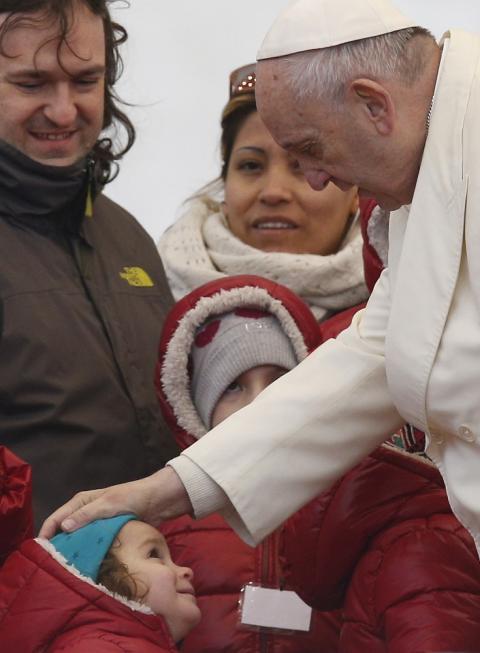
Pope Francis greets a child during his general audience in St. Peter's Square at the Vatican Feb. 14. (CNS/Paul Haring)
The broad consultation process used to prepare for the synods on the family has been welcomed worldwide as a sign of a new culture of dialogue in the church. It became clear that the church's sexual doctrine as a whole is understood neither in content nor in form because it has lost contact with the reality of human beings. A more intelligible form of proclamation alone will not be enough, since the gap is founded in the doctrine itself.
With the crucial statement in Paragraph 3 of Amoris Laetitia "that not all discussions of doctrinal, moral or pastoral issues need to be settled by interventions of the magisterium," Francis restored to the church the freedoms of dialogue and development of doctrine that his predecessor popes had curtailed beyond measure.
But Francis deliberately made no obvious corrections to doctrine. The question is why, for example, Amoris Laetitia deals in a blanket and undifferentiated way with the concept of indissolubility of marriage and why the question of when a marriage is considered a sacrament is ignored.
The controversial reactions to Amoris Laetitia show that the discourse intended by Francis about the long-blocked issues has started. But the reception of the teaching is far from complete, neither in the theological faculties nor in the parishes. Not since Humanae Vitae, the 1968 encyclical that affirmed the church's ban on artificial birth control, has a papal writing caused so much unrest in the church as has Amoris Laetitia. This time, however, in reverse: Now it is cardinals, bishops and some theologians who refuse the pope's course.
Yet Francis did nothing but adopt the principle of differentiation formulated by John Paul II's 1981 apostolic exhortation on marriage and family, Familiaris Consortio. Francis did open up ways — as John Paul did not do — for the church to deal with these difficult situations in a differentiated way.
With Amoris Laetitia and the decentralization intended by Francis, it is above all the bishops worldwide who now have the responsibility to "seek solutions better suited to [each country's] culture and sensitive to its traditions and local needs." To date, however, far too few episcopal conferences have followed the pope's invitation to develop appropriate pastoral responses that would be friendly to marriages and families for their respective cultural areas.
The German bishops, for example, didn't respond until Feb. 1, 2017. The long hesitation of the episcopal conferences is partly because, in the fall of 2016, four cardinals publicly declared their doubts about Amoris Laetitia and tried to enshrine as irrevocable for all the future the marriage doctrine formulated by John Paul II and Benedict XVI.
In addition to the major project of the synods on the family, Francis has engaged in countless other activities, initiatives and decisions that, combined, form a dynamic but well-considered transformation process based on the principles of the Second Vatican Council. While Francis is regarded as a conservative on values and he is not expected to make any quick dogmatic changes — for example, on the issues of sexual doctrines and of women's role in the church — he has shown a great willingness to listen and learn.
Scorecard on the issues
Laity: From the beginning, Francis has emphasized the importance of the people of the church, the so-called laity. The laypeople are the protagonists of the church and the world. The ecclesiastical hierarchy is called to serve them, not to use them. Here we see a completely different picture of the church than the monarchical and strictly hierarchical tradition: a picture of the church that finally corresponds to the communion theology of Vatican II.
Celibacy: Francis seems to be open to repealing mandatory celibacy for Roman Catholic priests. He has suggested he would consider ordaining "married men of proven quality" (viri probati). Although these statements are still vague, they are an important signal that an open debate is possible. Now it is up to the bishops, not to complain about the lack of priests to serve the pastoral needs of their diocese, but to send "brave and bold proposals" to Rome, as Francis told Bishop Erwin Kräutler in 2014.
Gay priests: Given his hopeful statement about gay priests, "Who am I to judge?", which earned Francis a lot of praise, the unchallenged exclusion of homosexuals from priestly ordination has been disappointing. A December 2016 document from the Congregation for Clergy, "The Gift of the Priestly Vocation," reaffirmed a 2005 instruction banning gay men from entering the priesthood. It leaves old assessments unquestioned and continues a false exaggeration of the role celibacy plays in the priesthood.
Women: The role of women is one of the most difficult and controversial matters within the Roman Catholic Church. Several times, Francis has emphasized that the church needs more women in all areas, especially in leadership positions. These comments were warmly received by many in the church, not just Catholic women's associations. Francis has appointed five instead of two women to the International Theological Commission.
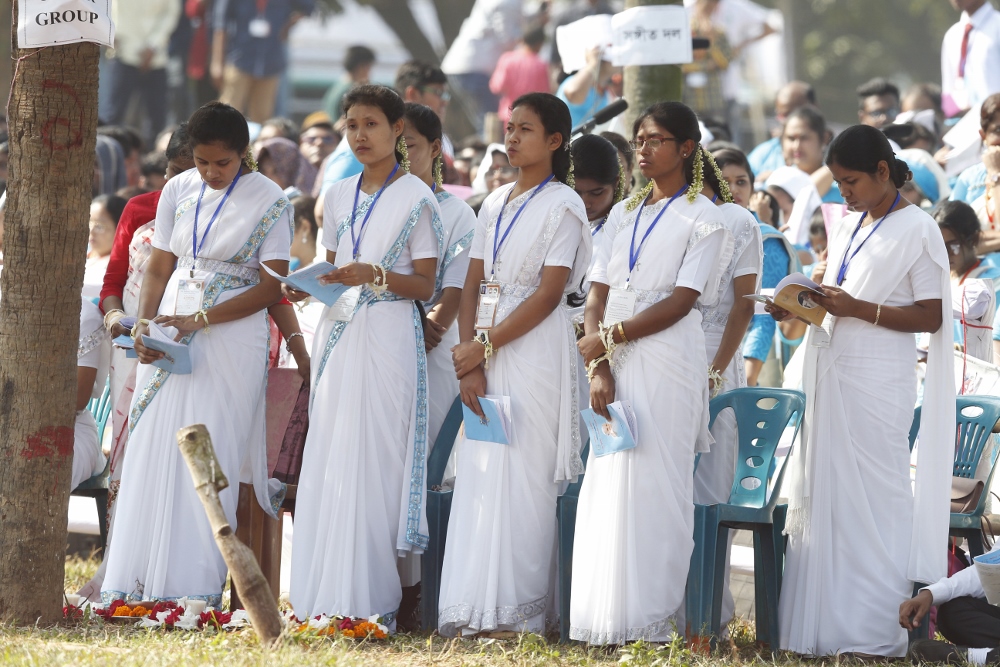
Women attend Pope Francis' celebration of Mass and the ordination of priests in Suhrawardy Udyan park in Dhaka, Bangladesh, Dec. 1, 2017. (CNS/Paul Haring)
But Francis has not yet sufficiently distanced himself from John Paul II's 1994 apostolic letter Ordinatio Sacerdotalis, which claims the ban on women to the priesthood is an unalterable ecclesiastical doctrine. Though prohibiting discussions about women's ordination imposed at that time had the opposite effect, John Paul and Benedict left a problem for their successors that is hard to overcome. When asked, Francis has declared the door to the priesthood to be closed to women. But he does after all use the image of a door — and, for this door, maybe a theological key can be found.
In the view of German Jesuit theologian Hans Waldenfels, Francis may have cracked open that door when in 2016 he recognized Mary Magdalene's role as the "true and authentic evangelizer." He also raised the July 22 memorial of Mary Magdalene to a feast on the church's liturgical calendar. Another theologian, Michael Seewald from Muenster, Germany, does not consider the previous arguments against the ordination of women to be valid and recommends a new debate on the priesthood for women.
Sexual violence: Recent years have seen intensifying efforts to fight against the sexual abuse of minors and the crimes of clerics, and to reform church structures to ensure the protection of children and vulnerable adults. Benedict XVI came slowly to this fight, but he set the church on an improved track. Francis has continued and reinforced what Benedict began. Francis has pronounced a zero-tolerance policy toward all delinquent offenders, and he has called all bishops to greater accountability, including those were involved in covering up abuse.
The results of his efforts have been mixed, as we can see in the case of the Chilean Bishop Juan Barros, accused of a cover-up. The Vatican has yet to explain why, after Francis received a letter from a Chilean abuse survivor, the Vatican did not act as it should have.
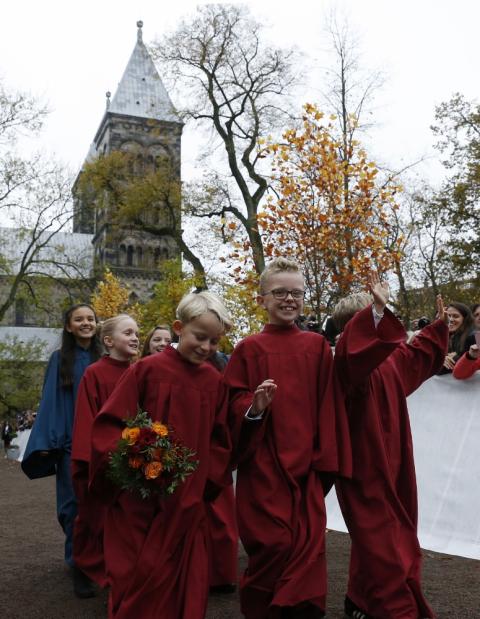
Children walk outside the Lutheran cathedral as they prepare to meet Pope Francis in Lund, Sweden, Oct. 31, 2016. (CNS/Paul Haring)
Ecumenism: Francis had an impressive visit to the Lutheran World Federation in Lund, Sweden, Oct. 31, 2016, which included a moving liturgy. The focus was on forgiving the sins of past centuries as well as celebrating progress made over the last 50 years. In contrast, Benedict's 2011 meeting with the Council of the Evangelical Church in Germany in Erfurt brought no "gifts." Germany has the unique situation of an equal number of Catholic and Protestant Christians.
As we mark the 500th anniversary of the Reformation, we would hope to see greater movement, especially around the question of the sharing of the eucharistic meal for marriages between Protestant and Catholic partners. According to Cardinal Walter Kasper, who for many years was the Vatican's point man on ecumenical issues, the Vatican has signaled that it would accept an opening on this issue, but the first move must be made by the bishops, who should make concrete proposals.
Liturgy: At the beginning of his pontificate, many thought that Francis was not particularly interested in liturgy. The appointment of Cardinal Robert Sarah as prefect of Congregation for Divine Worship and the Discipline of the Sacraments reinforced this impression. However, after a speech in London in which Sarah urged priests to celebrate Mass ad orientem whenever possible and announced a revision to the liturgical reform of the council, Francis stopped him, saying, in effect, "No reform of the reform!"
With his apostolic letter Magnum Principium, issued motu proprio ("on his own intiative"), Francis once again highlighted the intentions of the Second Vatican Council and returned the responsibility for the translation of liturgical texts to the national bishops' conferences.
Beatification and canonization: The simultaneous canonizations of Popes John XXIII and John Paul II can be seen as an attempt by Francis to reconcile two very different wings within the Roman Catholic Church. Francis' declaration of Salvadoran Archbishop Oscar Romero, murdered at the altar during Mass, as a martyr for the Catholic faith, and just this month making way for Romero's canonization, is a clear signal for a politically effective role model.
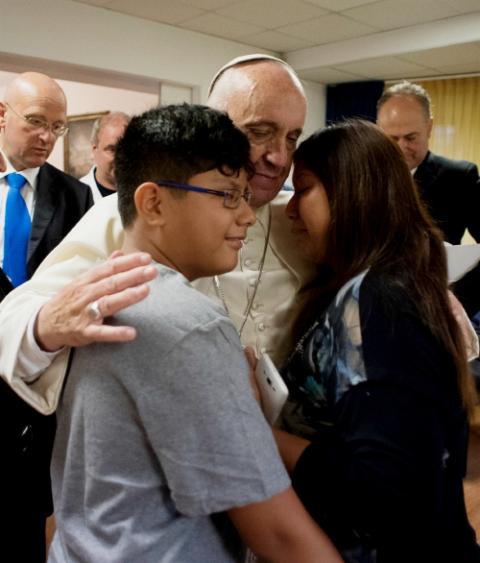
Pope Francis visits patients at the Villa Speranza hospice, which is connected to Gemelli Hospital, in Rome Sept. 16, 2016. The visit was part of the pope's series of Friday works of mercy during the Holy Year. (CNS/L'Osservatore Romano, handout)
Year of Mercy: With the rediscovery of mercy as the "first attribute of God" and declaring a churchwide "Holy Year of Mercy," Francis took a step in transitioning from a regulative understanding of the church to a church built on the foundation of the Gospel and open to all people in the world. This is also a clear sign of interreligious dialogue, which — along with his choosing the name "Francis" — can also be understood as an outreach to Islam.
Message for World Peace Day: With the message "Nonviolence: A Style of Politics for Peace" marking the 50th anniversary of World Peace Day Jan. 1, 2017, Francis appealed for peace through active nonviolence. This message, initiated by Pax Christi International and the Pontifical Council for Justice and Peace, is in many ways a paradigm shift in the understanding of the church's magisterium.
Reform of the Curia: Shortly after his election, Francis announced a reform of the Roman Curia. To aid him in this, he appointed a Council of Cardinals of eight (later nine) members, led by Honduran Cardinal Oscar Andrés Rodríguez Maradiaga of Tegucigalpa and with representatives from Europe, Asia, Latin America, Africa and North America. Outsiders undoubtedly find it difficult to see much progress in this reform and may wonder if it can really succeed. However, examining the list of men Francis has been appointing as new cardinals around the world shows that cultural diversity is being promoted.
Change is hard
Change is a laborious process that takes time to achieve and always generates resistance. The strength of the resistance to any kind of reform within the Vatican is evidenced in the sharp criticism Francis has delivered at annual Christmas receptions for the Roman Curia in which he has castigated them for "curial diseases."
Last Testament: In His Own Words, the 2016 book-length interview by journalist Peter Seewald with Benedict, who had promised not to speak publicly as the pope emeritus, is an indication of how much the struggle for the church's path continues. But the Jesuit Francis, with his decades of leadership experience even in the extremely difficult times of the Argentine military junta, seems to have already taken these reactions into account. Instead of quick decisions and fighting votes, Francis wants to initiate processes that should lead to consensus-based results.
Advertisement
From the beginning, Francis has had the support of the people of the church on a large scale, but we should be on guard against "pope euphoria." Francis' example and his "spiritual leadership style" alone will not be enough to break up the encrusted structures of the Roman church. "Absolutist systems cannot be resolved by continuous reforms; dramatic corrections and breaks are inevitable," says German theologian Hermann Häring. Therefore, a criticism of church leadership that is developed from the memory of Jesus and the issues of the present is indispensable.
But even a pope like Francis cannot achieve spiritual and structural renewal alone. He urgently needs support not only from reform groups, but above all from bishops and priests. In light of the ongoing attacks on Francis and on Amoris Laetitia, the Viennese pastoral theologian Paul Zulehner and the Czech sociologist and religious philosopher Tomas Halik started the international initiative "Pro Pope Francis" to support Francis' pastoral course. In Spanish-speaking regions, there is the initiative "Pro Papa Francisco."
The Roman Catholic Church is facing a decisive change now. After decades of refusing to accept the teachings of the Second Vatican Council, we must relearn how to dialogue within the church and how to conduct theological discourse. This won't be easy. New communication and leadership structures must be developed that meet the demands of the message of the Gospel as well as the requirements of a global religious community in the most diverse cultural areas. In addition, the church leaders must definitively address sexual violence and must urgently reassess the role of women in the church.
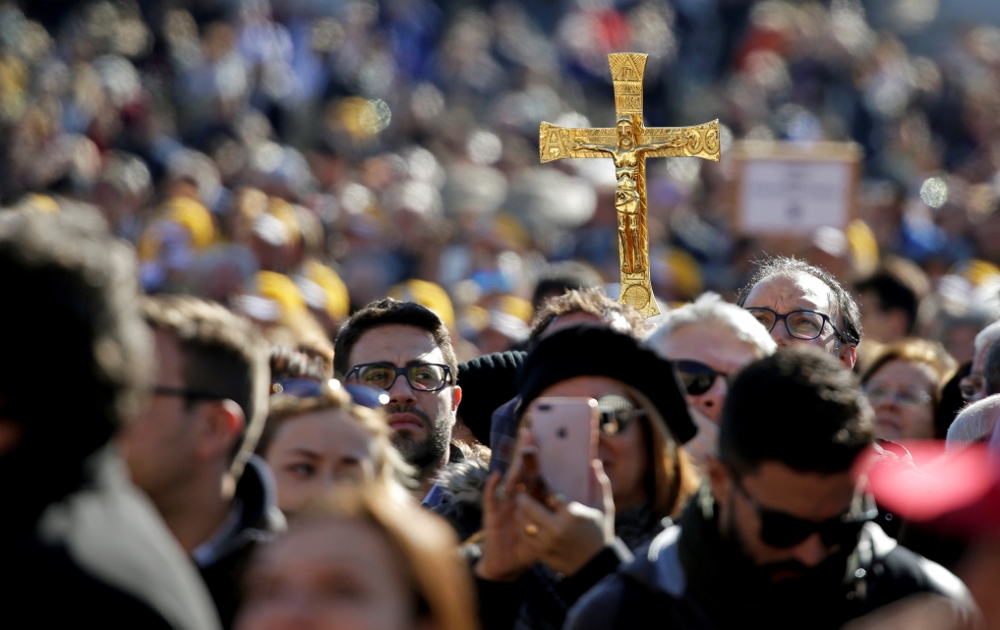
Faithful attend Pope Francis' Angelus in St. Peter's Square Feb. 4 at the Vatican. (CNS/Reuters/Max Rossi)
Francis desires a pastoral conversion, which is much more than just a pastoral reorientation. For this to happen, however, the people of the church and the theological sciences must again be much more actively involved and must also call for their own participation. Only in this way can Francis' pastoral conversion succeed.
The Roman Catholic Church is the largest "global player" ever. It has a great responsibility far beyond its own religious community and its own religious terms. The global community is watching whether and how the largest individual church body intervenes in the survival questions of humanity, and which ethical standards it proclaims and practices. Church reform and the survival issues of humanity are closely intertwined.
The crucial question for the future of all religions is what they can do to help solve the immense global, social and economic problems, and, above all, whether they find among themselves a peaceful coexistence. It is to be hoped that, after two restoration pontificates, the Roman Catholic Church will now be able to take up the course of reform set out by the Second Vatican Council and initiate the processes necessary for the Roman Catholic Church to take on a new and more positive role in the rapidly changing global human community.
[Christian Weisner is a co-founder of We Are Church International, which was started in Rome in 1996. He lives with his family in Munich, Germany.]
Editor's Note: A German-language verison of this article was first printed in HerderKorrespondenz earlier this month. An extended version „Wendezeit für die römische Kirche“ ("Turning time for the Roman church") will be published in May in ET-Studies 1/2018, Journal of the European Society for Catholic Theology.




